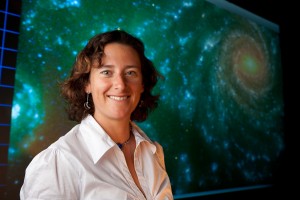
Archives
From plastic money to plastic electricity
How did we get here?
Zenobia Jacobs
University of Wollongong
Zenobia Jacobs wants to know where we came from, and how we got here. When did our distant ancestors leave Africa and spread across the world? Why? And when was Australia first settled?
These are difficult and controversial questions. But Zenobia has a deep understanding of time and how to measure it. She has developed a way of accurately dating when individual grains of sand were buried with human artefacts. And that technique is transforming our understanding of human evolution.
On the hunt for dark energy
Tamara Davis
University of Queensland / University of Copenhagen
In 1998 astronomers made an astonishing discovery-the expansion of the Universe is not happening at a steady rate, nor is it slowing down toward eventual collapse. Instead, it is accelerating. The discovery required a complete rethink of the standard model used to explain how the Universe works.
“Now we know that stars, planets, galaxies and all that we can see make up just four per cent of the Universe,” says Tamara Davis, a University of Queensland astrophysicist.
“About 23 per cent is dark matter. The balance is thought to be dark energy, which we know very little about.”
Big ecology: From tundra to savanna
Why are some plant seeds very small and others large? Angela Moles tackled this simple question by compiling information on 12,669 plant species. She discovered that plant seeds in the tropics are, on average, 300 times bigger than seeds in colder places like the northern coniferous forests. She then used these data to follow the evolutionary history of seed size over hundreds of millions of years.

The study was the first of its kind and the results, published in Science and PNAS, have revolutionised our understanding of the factors that determine the size of offspring in plants and animals. Angela is a leader in developing a new approach to ecology—one that could allow us to accurately model and predict the impact of climate change on ecosystems.
Continue reading Big ecology: From tundra to savanna
Are nanoparticles safe?
After two decades of research the first wave of nanotechnology consumer products are entering the marketplace in applications as diverse as catalysts, surface treatments for glass, cosmetics and drug delivery. But the properties that make them attractive to industry may also have unforeseen consequences. That worries Amanda Barnard, a physicist at The University of Melbourne.

“Many materials that are normally inactive—gold and silver, for example—become biologically active when the particles are just a few nanometres in size. So, if we are creating these new particles we need to understand how they will behave in the environment.”
Amanda believes she can create a theoretical framework that will allow the risk of nanoparticles to be determined in the computer—before the particle has even been made. She will use her L’Oréal Australia For Women in Science Fellowship to develop new computational tools to predict the behaviour of nanoparticles in the environment. Continue reading Are nanoparticles safe?
Crystallising a career in immunology
As a child, Natalie Borg tried to grow crystals. Two decades on, she is still growing crystals. But now she is analysing them with synchrotron light, to figure out how our bodies mount a rapid defence when we are attacked by viruses.

“The immune system is complex and is made up of many specialised types of cells and proteins. The key is to understand their function,” Natalie says.
To date, she’s been working as part of a successful team at Monash University. In 2007 her work on how our natural killer T cells recognise fats from invaders was published in Nature.
Now she’s setting up her own laboratory at Monash—a bold move but essential if her career is to grow. With the help of her L’Oréal Australia For Women in Science Fellowship, she will study key steps in our body’s early warning system against viral attack.
Life and love amongst the finches: Aggressive redheads win the best nest sites, but can the Gouldian finches survive?
Sarah Pryke has always had an eye for the shape, colour and movement of animals. After growing up surrounded by wildlife in a remote rural area of South Africa, she was employed as an illustrator by the local museum while studying for her science degree at the University of Natal.

Now, as a post-doctoral fellow of the at Macquarie University in Sydney, she is working in the Kimberleys investigating the impact of colour on the behaviour of the Gouldian finch, a small, dazzling bird of Australia’s tropical savannah.
With the help of her L’ORÉAL Australia For Women In Science Fellowship she plans to get a better understanding of their mating success – information that could be crucial to the survival of these endangered birds. Continue reading Life and love amongst the finches: Aggressive redheads win the best nest sites, but can the Gouldian finches survive?
New ways of looking at old diseases: An African sojourn confirms a vocation in sexual health
When Catriona Bradshaw volunteered as a visiting medical officer in sexual health and HIV medicine at an African hospital, it was a turning point that confirmed her career choice – in sexual health.

Now, with the help of her L’ORÉAL Australia For Women In Science Fellowship, Bradshaw plans to clear up confusion about a common genital infection of women – bacterial vaginosis.
She suspects that bacterial vaginosis may be sexually transmitted. By studying the spread of the disease in young women she plans to determine if this is the case.
She hopes that her work will lead to improved treatment regimes – benefiting women in the West and in developing countries.



